Archives
29 September, 2017

The last day of our previous exhibition, Call Me By My Name: Stories from Calais and beyond, was Sunday 20 August; the dismantling and de-installing of the exhibition started the next day and was completed in a matter of days. Exactly one calendar month later our new exhibition, No Turning Back: Seven migration moments that changed Britain, opened, on Wednesday 20 September in our space at The Workshop, 26 Lambeth High Street.
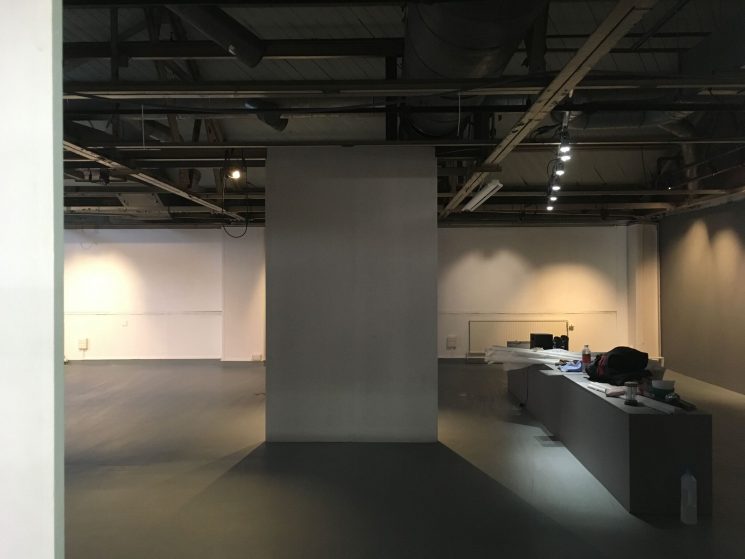
The Migration Museum at The Workshop, two days after ‘Call Me By My Name’ closed to the public.
In the four weeks between the two exhibitions, the rooms in our first-floor premises were completely reconfigured, the walls made good and repainted, new structures put on the window areas, new lighting installed, the floor repaired where necessary . . . oh, and the new exhibition installed, bringing together the work of twenty-odd artists, much of it commissioned specifically for this display (thanks to our generous sponsors).

Koto Akyoshi and Ariadna Martinez (volunteers, both) working on the exhibition’s distinctive mustard paint.
Leaving to one side for the moment the fact that this exhibition was conceived, researched, commissioned and delivered within a mere nine months (an in-human gestation period), you have to wonder, ‘How was this possible?’
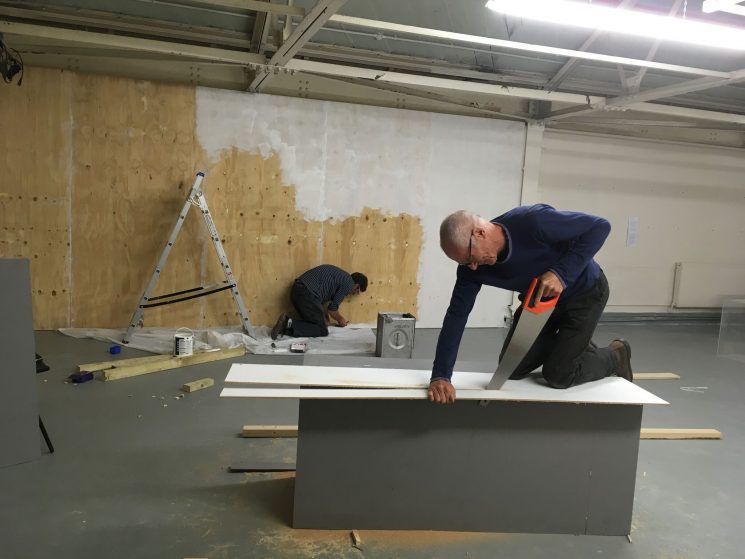
Andrew Steeds (MMP project manager) works on the new plinth for Roman Lokati’s sculpture, while Martin Cottis (joiner supremo) works in the background.
It’s a long roll-call, and it would be a mistake to get all Oscar-ceremony about it, but the most significant contribution outside our immediate team came from our volunteers. No doubt all charitable organisations depend on the goodwill of their volunteers, but the generosity of those who routinely turn up to staff our exhibitions, facilitate events and help us in the day-to-day running of our project is staggering. In addition, for No Turning Back, a large number of volunteers researched the seven historical moments that form the backbone of the exhibition, clarifying historical data, sourcing photographic and other records of the time, tracking down quotations to frame the display. And then many of them turned up to paint the museum and get the physical structure ready for the exhibition itself. This time the expression is absolutely true: we couldn’t have done it without them.
The two members of our team who were centrally responsible for putting the exhibition together (and whose current recuperation is therefore richly deserved) are Sue McAlpine and Aditi Anand. But Sue and Aditi would be the first to say that their work would have been impossible had it not been for the input not only of the volunteers just mentioned but also, crucially, that of our trustee Robert Winder and education committee member Martin Spafford, both of whom were instrumental in shaping the historical structure of No Turning Back.
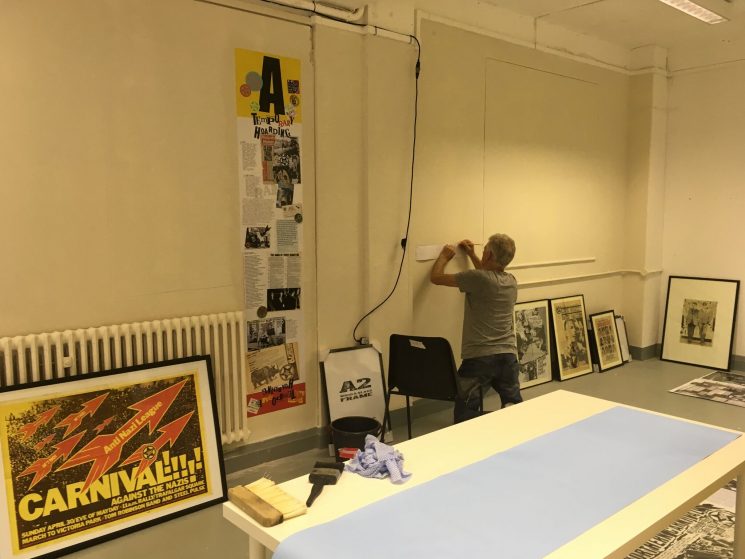
Andy Dark at work on the Rock Against Racism section of the exhibition.
However back-breaking it may be, this ability to assemble an exhibition in a period of time that most more-established institutions would find difficult has the huge advantage of allowing us to respond to current preoccupations while they are still viscerally significant. We were able to do that last year with Call Me By My Name, and all the signs are that we have done so again this year with No Turning Back. Conceived in the wake of the EU referendum debate, and the apparent schism in the country that it engendered, the current exhibition allows us to question whether this is a unique moment or whether in fact there have been previous pivotal points in our history that were equally significant to our attitude to influxes of people or to our engagement with the wider world.
Each moment, we hope, will be controversial, raise questions and provoke the occasional ‘I didn’t know that!’ moment. The historical starting point is the expulsion of the Jews in 1290, the only moment in British history – so far – when a complete race or religion was forcibly banished from the country. The other bookend is the 2011 Census, which revealed a dramatic growth in people self-identifying as mixed-race or mixed-heritage. In-between, there are five other moments (come and see for yourselves!) all of which have resonances for our current position. What happened? How did it happen? What was the human fall-out? What if something similar happened now . . . ? – these are some of the questions we hope will be raised by the display.

Emily Miller (MMP education officer) and Faiza Mahmood (MMP events co-ordinator) assembling Angelicá Dass‘s ‘Humanæ’ display; portraits Angelicá took of Lambeth and Southwark residents will be added to the display in October.
But this is not a dry academic account of seven moments in our history. The whole display is peopled by quotations, past and present, illustrating each theme, and on the floors and walls artists give their response to the events featured. The whole impression is history re-processed through a contemporary sensibility.
We hope the exhibition will get people thinking, discussing and arguing; and we plan to run a raft of events and activities that take the conversations forward. We have selected seven moments that seemed to us significant, but there is no suggestion, of course, that these are the only seven moments that could have been selected. Let us know the moments that you think we should have chosen. Eventually, we hope, all of them will be given due prominence in the permanent space to which our current temporary premises in Lambeth act as an inspirational curtain-raiser.
So we know now how we got the physical space from there to here, and huge thanks are due to everyone who helped in the process, all of whom went above and beyond. No Turning Back itself, of course, will ask the much more challenging questions: ‘How did we get here?’ and, more teasingly, ‘Where do we go from here?’
Thanks to our volunteers who helped us to set up and staff our current exhibition: Alastair Wiltshire, Alex Siu, Alice Lepage, Alizeh Hameed, Anna Marsden, Ariadna Martinez, Assunta Nicolini, Beatrice Burrows, Beth Taylor, Brenda Martinez, Beatrice Duguid Cox, Emily Rose Edwards, Gargie Ahmad, Holly Langham, Jasmine Jones, Jessica O’Connor-Tomlin, Jessica Lumanisha, John Gomez, Koto Akiyoshi, Kyriaki Kamenou, Lara Ertener, Maria Pintado, Max Evans, Mona Jamil, Naheed Bilgrimi, Nathan Evans, Rosa Evans, Sam Cumming, Sophie Rees Rumney, Tanya Costa and Uzma Ravat.
13 August, 2017
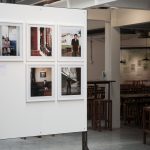
In 2010, Simon James took a series of photographs for an exhibition which he called Home, 2010. This was a series of portraits with handwritten answers to a questionnaire alongside the photos. The questionnaire asked the subjects of their photos a series of factual questions –name, home town, nationality, part of London they lived in, occupation, time of arrival in the UK, mode of transport to the UK – together with some that were more opinion-based: what did they find the strangest thing about England, what was their favourite British food, did they every plan to go back home to live (and, if so, when), what they did in London that they never did back home, and what they most missed about home. The portraits and the questionnaires can be viewed on Simon’s website.
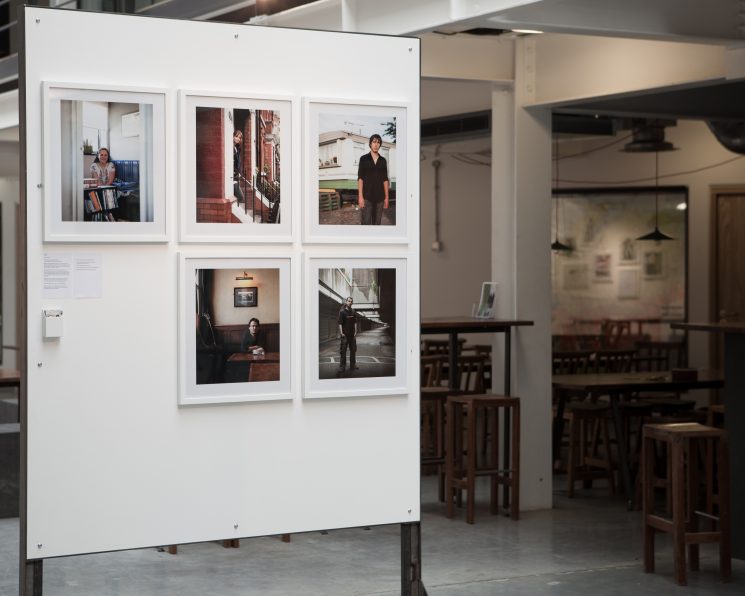
Simon James‘s ‘Home, 2010’ exhibition, first shown as part of ‘Alien Nation: the art of blending in’, Great Western Studios, London. March–April, 2011.
In his notes to the exhibition, Simon framed the collection in this way:
‘One should not be an alien at all.’
George Mikes, How To Be An Alien (1946)
Mikes’s book highlights the absurd cultural contradictions between England and continental Europe. England is a nation of immigrants. Throughout history waves of immigrants have chosen London as their new home.
Ten of the twelve most recent accession nations to the EU have been eastern and central European countries. Citizens from these nations are entitled to work in the UK, but have limited access to benefits and social provision. Since 2004 there has been a noticeable increase in migration from these countries to the UK.
Many of these new arrivals have been met not only with scepticisim but sometimes also with hostility. They found a very different England from the one they had expected.
It is these people that you see in these photographs.
These beautifully constructed portraits hint at common experiences of migration: almost to a person, what the subjects most missed about home was family, friends and food. Similarly, despite a clearly critical position on British cuisine, there was general admiration for Sunday roasts, steak pie and those two other stalwarts of British eating: fish and chips (ours courtesy of the Portuguese) and pizza (our national Italian dish). And the things that they found strange about England and Britain held few surprises: driving on the ‘wrong’ side of the road, separate hot and cold water taps and, again, food.
Simon and the Migration Museum Project were in discussion again earlier this year, when the exhibition at Roast Restaurant in Borough Market was being planned. Reluctantly, we decided that his photos didn’t quite meet the criteria of that exhibition, but we ended up talking about a follow-up to Home, 2010, to see how the subjects’ answers to the questionnaire might have changed in the wake of the June 2016 referendum on the UK’s membership of the European Union. An e-mail was duly sent out to everyone he’d photographed, asking them to give their answers now to the opinion-type questions on the original questionnaire.
The people whose photographs appear in this blog answered the e-mail, and their answers are given here underneath the original photos of Simon’s 2010 exhibition. There’s nothing scientific about this ‘research’, of course, but the set of eight answers gives a sense of the mobility (or temporary nature) of migration – many subjects had gone on elsewhere or returned home (and we could speculate endlessly about the reasons the others didn’t answer the e-mail) – and a hint of a darkening mood since last June. Maciek, who in 2010 had said he had no plans to go home, now writes ‘Yes, very soon! If not Poland, then France/Italy’; Arleta, who previously wasn’t sure, is now thinking about it; Filip and Hanna have both left already (as they had said they would in 2010), Hanna now citing that the thing she finds strangest about England is ‘Brexit’. It would be interesting to track down more ‘before’ and ‘after’ stories of this kind and to revisit these eight subjects in a year or two’s time: it is often a useful corrective to have anecdotal and human evidence set against the statistical findings trotted out by competing positions on Britain’s departure from the EU.

Arleta, and her responses in 2010. © Simon James
Arleta, 2017 responses
- What job do you do in London?
Accountant day time/landscape photographer at weekends.
- Strangest thing about England?
Two separate taps – one with very cold water and other with boiling hot water.
- Do you ever plan to go back home to live? If so, when?
I’m thinking about it but I haven’t made up my mind yet.
- What do you miss most about home?
Mushroom picking in autumn.
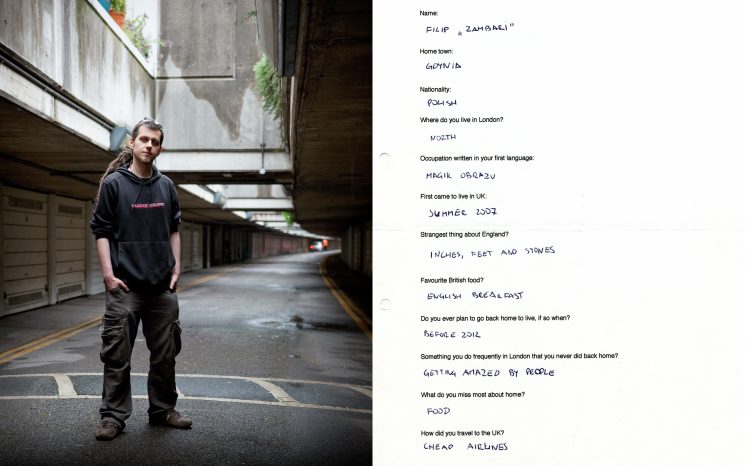
Filip, and his responses in 2010. © Simon James
Filip, 2017 responses
- What job do you do in London?
Graphics design and video post-production for a production house in Camden.
- Strangest thing about England?
Separate taps for hot and cold water. Calling normal taps ‘continental’; in general, your insistence on calling stuff ‘continental’ felt strange, but it makes more sense now since you voted for Brexit.
- Do you ever plan to go back home to live? If so, when?
I did come back already actually, back in 2012.
- What do you miss most about home?
London was great, top of the world and all, but it was also very competitive. At home I don’t have to prove who I am, there’s less possibility but also less stress; at home I’ve got more time to learn new stuff and I have more room to make mistakes (which are essential if I want to make progress).
On the other hand:
I think what I miss most about London is the architecture, mainly the brutalist style that I am in love with, starting from well-known estates like the Barbican or the Southbank, I just kept stumbling on some totally amazing pieces of architecture on my cycle journeys through the city like the Heygate estate or Alexandra Road Estate, which I picked for Simon to take a picture of me, but literally dozens of other amazing spaces that just kept forcing me to stop and gaze for a while each time I took a different route home.
That would be one thing that I never did back home – call my girlfriend and say, ‘Honey I’ll be home a bit later, I just discovered this another awesome building and I positively need to see how it looks from another side before I move on.’
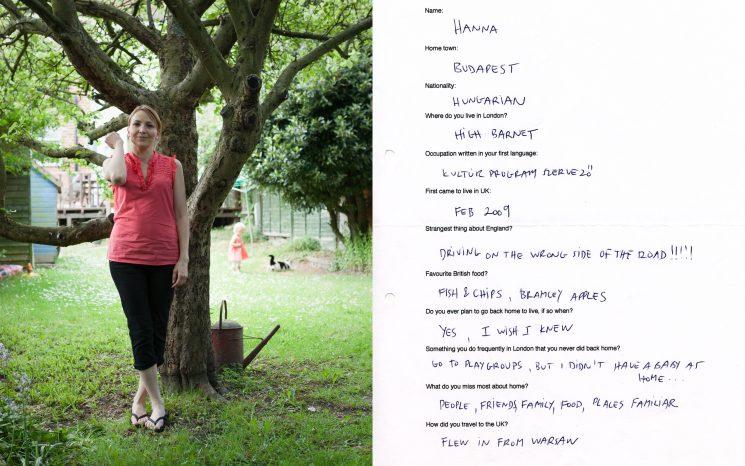
Hanna, and her responses in 2010. © Simon James
Hanna, 2017 responses
- What job do you do in London?
I no longer live in London. My last job was working in marketing for a broadcaster, mostly looking after their Eastern European business.
- Strangest thing about England?
Brexit.
- Do you ever plan to go back home to live? If so, when?
I have since moved to Warsaw, Poland (so not home), and now I live in Southern California. I do plan to move back home for retirement though.
- What do you miss most about home?
Familiarity. Family and friends. Language.
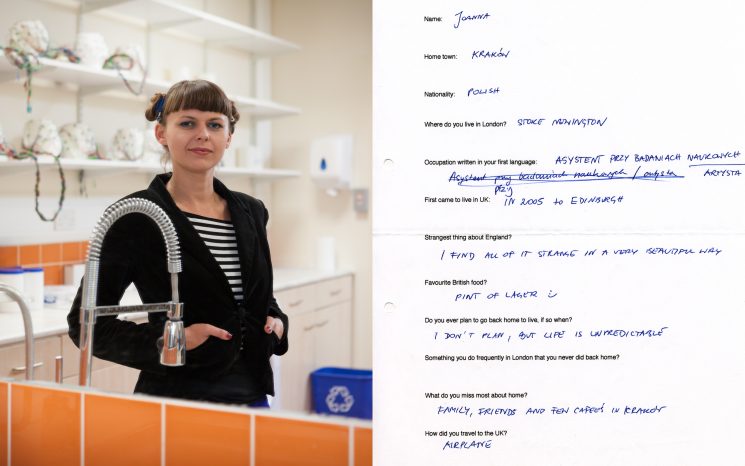
Joanna, and her responses in 2010. © Simon James
Joanna, 2017 responses
- Strangest thing about England?
Separate taps for hot and cold water; hand washing can turn into a nightmare.
- Do you ever plan to go back home to live? If so, when?
No plans at the moment.
- What do you miss most about home?
Family and friends and my mum’s cooking.
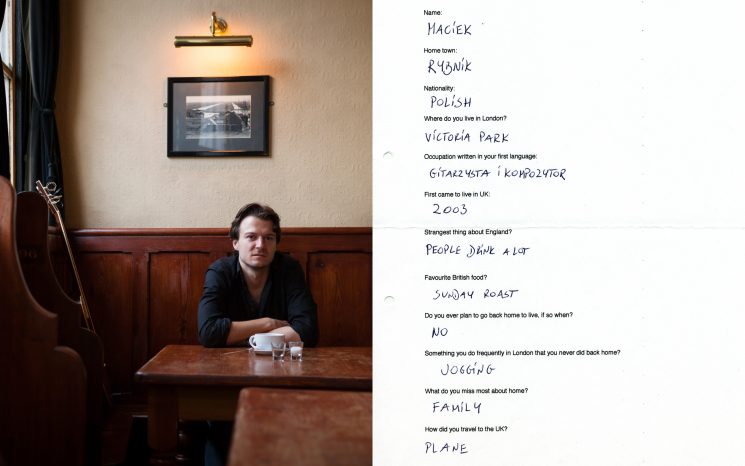
Macíek, and his responses in 2010. © Simon James
Macíek, 2017 responses
- What job do you do in London?
Musician/composer/guitarist.
- Strangest thing about England?
Separate cold and hot water taps!
- Do you ever plan to go back home to live? If so, when?
Yes, very soon! If not Poland, then France/Italy.
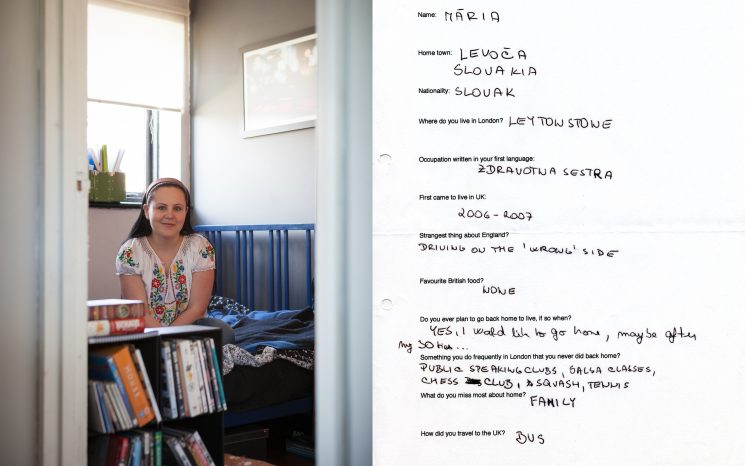
Māria, and her responses in 2010. © Simon James
Māria, 2017 responses
- What job do you do in London?
Property investor.
- Strangest thing about England?
Weather and food, English manners.
- Do you ever plan to go back home to live? If so, when?
No, but I’m considering other options such as Asia or Dubai (temporarily).
- What do you miss most about home?
Our large quiet garden, better weather, cheaper restaurants and services.
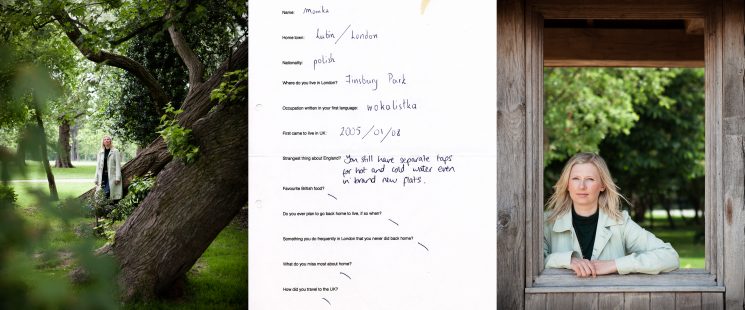
Monika, and her responses in 2010. © Simon James
Monika, 2017 responses
- What job do you do in London?
Singer, songwriter, singing teacher.
- Strangest thing about England?
Food: sandwiches with chips, beans on toast.
- Do you ever plan to go back home to live? If so, when?
Not at the moment, but we will see how it goes.
- What do you miss most about home?
Family and friends.
- Something you do frequently in London that you never did back home?
Going to pubs – we haven’t got pubs in Poland.

Wojciech, and his responses in 2010. © Simon James
Wojciech, 2017 responses
- What job do you do in London?
I am an artist. My jobs are my projects and also the services I perform for galleries and collectors in the care and condition of art collections.
- Strangest thing about England?
That the country of such great traditions – cultural, technological, politically liberal – can sink so low as it has done recently in adopting euro-sceptic point of view reserved until now to a narrow group of MPs such as John Redwood, Bill Cash and a Daily Mail lobby.
- Do you ever plan to go back home to live? If so, when?
I am rooted to deeply now and my mother country is suffering from the very same illiberal affliction. It would have to get a lot worse before I would do that but ‘Events, dear boy, events’, as Macmillan once had said, are unpredictable.
- What do you miss most about home?
Familiar touchstones – such as sights, well-spoken words, theatre, warmth of family and friends
- Something you do frequently in London that you never did back home?
Listening to BBC Radio3, my favourite radio station, closely followed by John Humphries and James McNaughtie – the great news men from Radio 4.
There is more information about Simon James, and more of his photographs, on his website:
www.shotbyjam.com
19 July, 2017
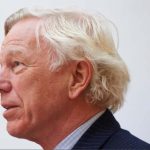
How long do you have to live somewhere before you are accepted as belonging there? A friend moved to a village in Devon 30 years ago and is now leader of the parish council. But she regularly finds her proposals or decisions challenged by another council member, who invariably begins his sarcastic intervention, ‘Well, as someone whose family have lived in this village for only the last 500 years . . . ’ My friend ruefully reflects that it will take her somewhere between 30 and 500 years to be accepted into the community in which she has chosen to raise her family.
Defining national identity is an equally tricky undertaking, whether for a person or a country. Post-referendum – and even before, as the UK citizenship test demonstrates – trying to work out what it means to be British is a bit of a national preoccupation, and one that British politicians routinely come unstuck on. It’s something that at least three distinguished friends of the Migration Museum Project (Robert Tombs, Robert Winder and Afua Hirsch)* have written about or are currently writing about – and they are not alone: type ‘Britishness’ into the search engine of Amazon and you’ll come up with just short of 100 books on the subject.
Defining national identity on a personal level is no less complicated. The passport you own is one factor, but many people who hold a British passport self-identify as any number of things (English, Welsh, Scottish, Irish, European, Jewish, Muslim, Black) before they identify as British – we are way beyond the Norman Tebbit test of which national cricket team you support.
And then, as Johanna Konta has reason to understand this Wimbledon, and numerous other sportspeople before her (Mo Farah, Greg Rusedski, all the way back to Basil D’Oliveira), being famous doesn’t bring you immunity from other people’s speculation about your identity. You may call yourself British, you may have a British passport, but that doesn’t necessarily mean that some journalists, and others, accept you as British.
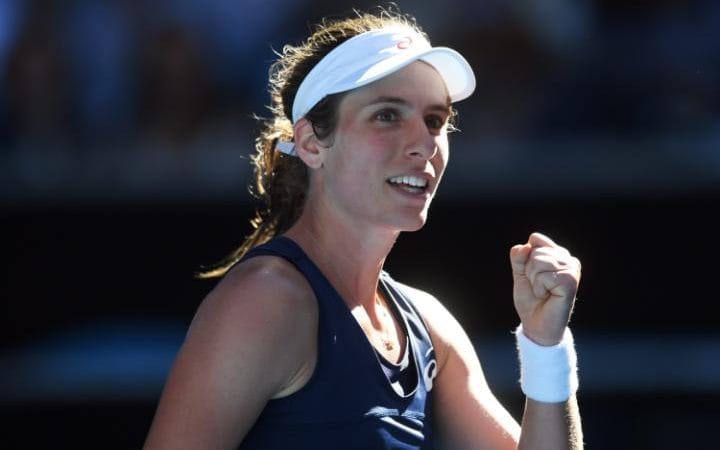
Johanna Konta, the latest in a long line of British sportspeople to be questioned about their ‘Britishness’. © Telegraph
National identity is hardly homogeneous either – last year’s referendum and this year’s general election have shown how many different kinds of Britishness and Briton there are in this country. And this isn’t a new phenomenon. Let us take another of our distinguished friends, Sir Konrad Schiemann, who was orphaned in Germany and brought over to this country by his uncle, Werner von Simson: their experience was played out more than 70 years ago but will still reflect that of many people who are in the process of making the United Kingdom their home.
Werner had married an English woman in 1938 and came to England a year later, in June 1939, for the birth of their child in June 1939. He was in this country when war broke out and, having seen what was happening in his country of birth, Germany, and wanting no longer to be part of it, he stayed here. This didn’t stop him being rounded up along with other ‘enemy aliens’ living in Britain when Churchill gave his (in)famous order to ‘collar the lot’. Irrespective of how long you had lived in the country, or what your political allegiances might be, you were gathered together by ‘national identity’ and, in Werner’s case, sent to spend the war on the Isle of Man. The same thing happened to Konrad’s wife’s mother and grandfather – the musicologist O E Deutsch – who had fled Austria.
On the Isle of Man, German might have been a unifying language among the internees, but German Jews found themselves rubbing shoulders with Nazi sympathisers, communists with fascists.
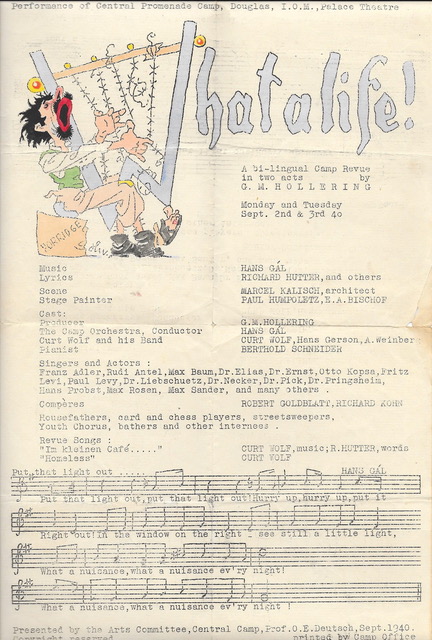
The programme notes for ‘What a Life!’, a camp revue put on in Douglas on the Isle of Man in September 1940.
(O E Deutsch’s story is one we have touched on before. While on the Isle of Man, he was involved in the production of What a Life!, a bi-lingual review that was put on in Douglas in September 1940. One of the songs from the review was performed by Norbert Meyn at the launch of our Germans in Britain exhibition in 2014.)
Werner brought his nephew, Konrad, to this country in the aftermath of the war. Konrad, born in Germany in 1937, lost both parents in the final stages of the war, his father being shot by partisans in Italy just months before VE day and dying shortly after, and his mother dying of a broken heart in Germany’s ravaged capital, Berlin, to which she had returned in the hope of being reunited with her husband.
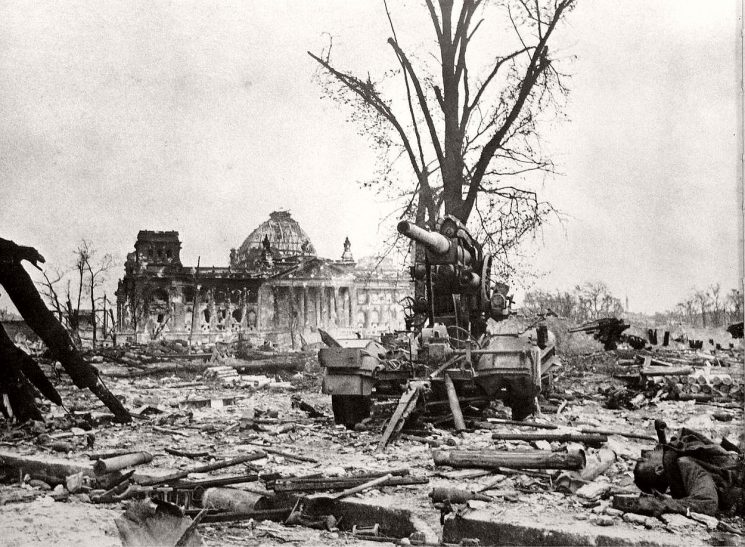
Berlin in 1945 lay mostly in ruins. Konrad Schiemann and his mother were living in 64 Eichenallee, Westend, a house that was, as his uncle Werner wrote, ‘intact – it must be one of the very few houses which are’. © Monovisions
The circumstances of the newly orphaned Konrad’s removal to this country are conveyed in a series of letters, the first written in German by the 8-year-old Konrad himself (my translation):
10 Dez 1945. Liebe Tante Janni, ich werde Dir eine traurige Nachricht geben, dass Mutti krank geworden ist, weil wir ein Telegramm gekriegt haben, das lautet: das Papi grosses Pech haben musste, in den letzten Tagen von Partisanen überfallen zu werden. Er wurde am 30.4.45 verwundet und ist dann durch Versagen des Herzens am 3.5.45 im Teillazarett D in der Nähe von Padua gestorben (Grab Nr.178). Viele Grüße an Bettina, Andreas und Tante Hilda Dein Konrad.
10 Dec 1945. Dear Aunty Janni, I am going to give you some sad news. Mummy has become ill because we have received a telegram telling us that Papa had the really bad luck to be attacked by partisans in the last days [of the war]. He was wounded on 30 April 1945 and died on 3 May 1945 in the Teillazarett (hospital) D near Padua following a heart attack (grave number 178). All good wishes to Bettina, Andreas and Aunty Hilda. Your Konrad
Konrad’s mother, Beate, died on 10 January 1946, and Werner then volunteered to adopt the young orphan himself and bring him up in England as a member of his family, an arrangement in line with Beate’s wishes. In response to a letter from him, Werner’s father, agreeing with his suggestion, had this to say about the process of naturalisation (my translation):
Säge, 14 March 1946
My dear old Werner
I’d like next to say that I fully and unconditionally agree with everything you say. Now, the matter of your own naturalisation: I’ve always held the position, because of my own considerable experience of living abroad, that people who have come to feel really at home in another country can become essential promoters of good relations and rapprochement between the country of their birth and their adopted country only if they take on the nationality of their adopted country. Taking that further, even before these last twelve years, and especially before these last seven, I would always – since you are kind enough to value my agreement – have been happy about your becoming English. After these last years, in which sadly I have completely lost any connection (at least for the moment) with my fellow countrymen and women and can’t for now imagine – given the way in which they have behaved – how I will ever rediscover it, I approve of your actions all the more, an approval which is mixed with a slight sense of envy. What you have to say about Konrad’s future also meets with my full approval. On reading Ätchen’s will [Ätchen is Beate, Konrad’s mother], I said at once that for Konrad to be accepted into an English house and an English school would be possible only if he were himself to be brought up completely as an Englishman. That would have been desirable even in friendlier times; now it seems to me imperative. Ätchen’s wishes can be met only if the child were either to be placed under your guardianship in a German boarding school or allowed to become English as soon as possible.
For many immigrants, becoming English as soon as possible involves changing your family name to make it less ‘foreign’. With people from German-speaking countries, this process involves what Professor Rudiger Goering (previously Rüdiger Göring) in a lecture on George Frideric Handel (previously Georg Friedrich Händel) wryly referred to as ‘the inevitable shedding of umlauts’ and other German-specific sounds, such as changing ‘mann’ to ‘man’. Rather famously, one hundred years ago this week (17 July 1917) the Saxe-Coburg und Gotha family decided to change its name to the more English ‘Windsor’. Under the conditions of his mother’s will, Konrad kept his German name, an omission that Quentin Hogg (Lord Hailsham – a Conservative grandee and one of the longest-serving British politicians) mentioned on meeting Werner when Konrad was being sworn in as a judge. When Hailsham commented that Konrad had never ‘anglicised’ his name, Werner responded, ‘We’re not the royal family, you know.’
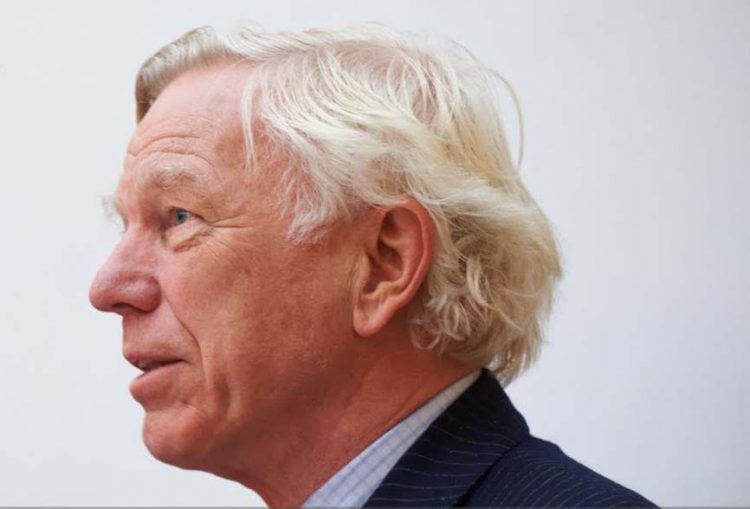
Sir Konrad Schiemann, barrister and judge and distinguished friend of the Migration Museum Project. He served the Court of Appeal and was also a member of the Court of Justice of the European Union.
Reflecting on his upbringing earlier this year, in an Inner Temple lecture on ‘What is Europe?’, Konrad Schiemann (who went on to become a barrister and judge, serving both the Court of Appeal and the European Court of Justice) confesses to be ‘one of the foreign-born workers and pensioners whose presence in this country clearly many find disturbing’. On paper, of course, he is the quintessence of Britishness – direct grant school in Birmingham, national service, Cambridge University degree, barrister, knighted in 1986 – and yet in a bizarre twist of events, and despite his having lived in this country for over 70 years, his British identity has come to be challenged since the referendum. As he said in the same Inner Temple debate:
Fortunately, throughout my time in this country, I have never felt myself hated – until, that is, the debates around the recent European referendum, when to my astonishment I found myself for the first time treated by some with whom I used to have a perfectly friendly relationship as an enemy of the people. I know German Jews who were equally astonished when the same thing happened to them in the 1930s.
In the months and years that follow, as we renegotiate our relationship with Europe and the wider world, those of us who call ourselves British – whether we have lived here for 30 years or for 500 – might do well to consider what it might mean to our national identity to define it so narrowly as to rule out so many who have – in sport, culture, commerce, law, politics and day-to-day living – enriched it beyond possible calculation.
* Robert Tombs, who gave our annual lecture in 2015, is the author of The English and their History, which is in many respects an attempt to provide a historical explanation of how we got to be the nation we now are. On 27 July, Robert Winder, whose book Bloody Foreigners was the early inspiration for the Migration Museum Project, publishes The Last Wolf: The hidden springs of Englishness, a book that attempts to identify the ingredients of the English national character. And early next year there is a new book by Afua Hirsch, Brit(ish): Why we need to talk about race, a book that also explores the identity crisis at the heart of Britain today, but from a racial perspective.
8 June, 2017
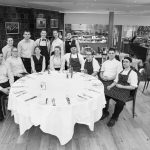
A new exhibition has opened in Roast restaurant in London’s Borough Market, founded by a distinguished friend – and generous supporter – of the Migration Museum Project, Iqbal Wahhab. Here Iqbal talks about the circumstances that provided the unfortunate inspiration for the exhibition.
No one really knows what’s going to happen post-Brexit. But we do know what’s happened post-referendum. An ugly antagonism towards Europeans has somehow unleashed a respectable racism – respectable, because it reflects the will of the people. Physical and verbal attacks have become common, and it was an incident in Roast, the Borough Market restaurant I created 11 years ago, that triggered the collaboration of the Migration Museum Project (MMP) for an exhibition currently on display on our walls.
This is what happened. A senior waitress told me that, soon after the vote, a customer had asked her where she was from; when she replied that she was from the Czech Republic, he asked her: “What are you still doing in our country?” I was repulsed when I heard that, angry that such ugliness was allowed to manifest itself with no filter for decency. That anger triggered many more thoughts, the first being that, apart from the rise of Islamophobia, Britain lives in a more racially tolerant time than when I grew up in the 1970s around south London, when Paki bashing and the National Front were the order of the day.
I’d hoped that no community would ever have to face what we had had to endure.
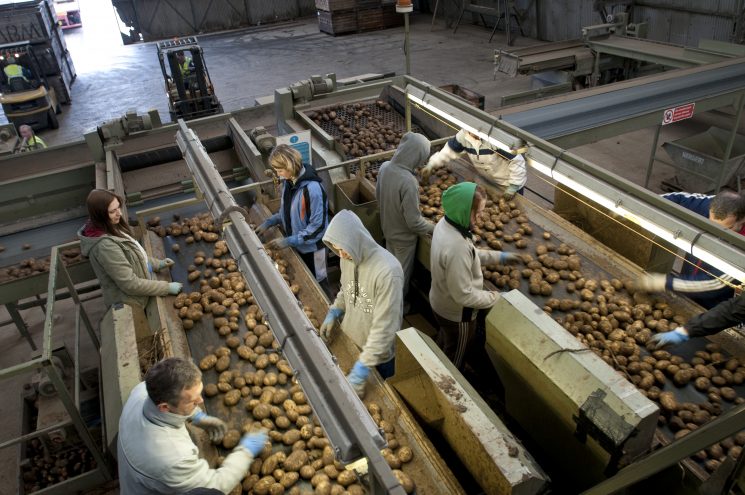
Workers sorting potatoes on a Lincolnshire farm. According to a National Farmers’ Union survey, almost 85 per cent of the seasonal workforce in British agriculture was from Romania or Bulgaria as of September 2016. Photograph © Jason Bye
Yet here, in a smart central London restaurant, an elderly man in a business suit deemed it legitimate to talk in such a fashion. It occurred to me that us so-called liberal elites have largely kept quiet about what is happening all around us. The Brexiteers won the vote, but how many of them would have predicted the opening of this can of vicious worms is hard to tell. I told the hardline Brexit campaigner Daniel Hannan MEP about this incident, and he was genuinely shocked. In London, many of us are. But what are we doing about it? How are we challenging the prevailing prejudice?
I hear many horror stories of how French, Spanish and Italians in London are being treated, but it’s those from eastern Europe who are facing the brunt of this ugly resentment – for taking “our jobs”, jobs, we all know, that it would have been hard to find candidates for from locals. So I asked the MMP to help me, in our own small way, to make a subtle but powerful message – that eastern Europeans have, like all previous migrant settlers here, made huge contributions to British culture and our economy. Our exhibition, Unsung Stories – Eastern Europeans in Britain, communicates that message.
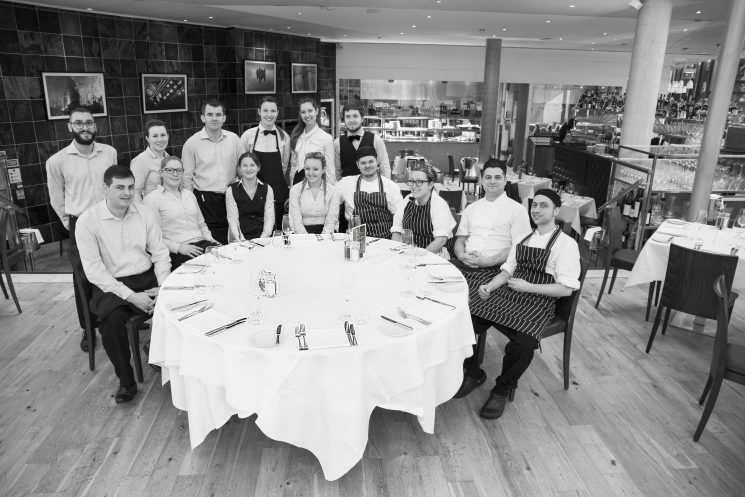
Three-quarters of the team that brings you the very British experience at Roast are European. This was taken by Egle Puzaraite, who comes from Lithuania, was previously a head waitress at Roaast, and is now a professional photographer. ©Egle Puzaraite
At Roast, 75 per cent of our team are European. People from Poland, Hungary, the Czech Republic are, ironically, the driving force behind the country’s most successful traditional British restaurant (founded by someone born in Bangladesh). This delicious diversity should make us hold our heads high with pride, yet we find ourselves bowing our heads in shame. Whatever happens with Brexit, we must conduct ourselves with greater dignity. The exhibition is a celebration, and we have much more to celebrate than we have allowed ourselves to do.
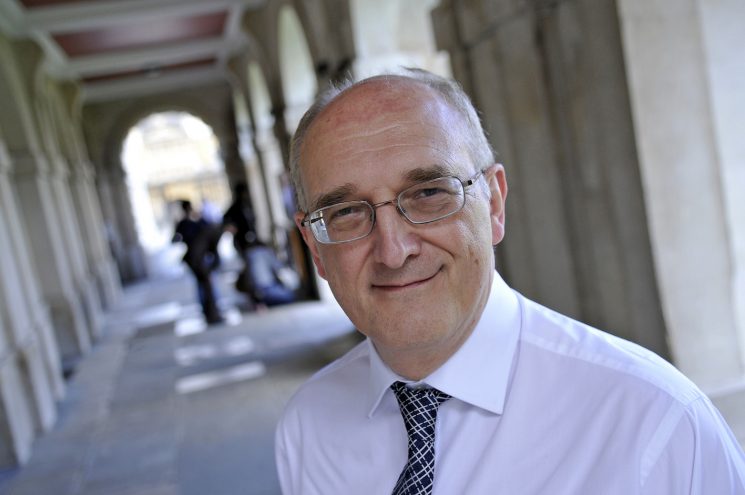
Sir Leszek Borysiewicz, immunologist and vice-chair of Cambridge University, was born in Wales to parents who were Polish refugees of the Second World War. Photograph © Phil Mynott
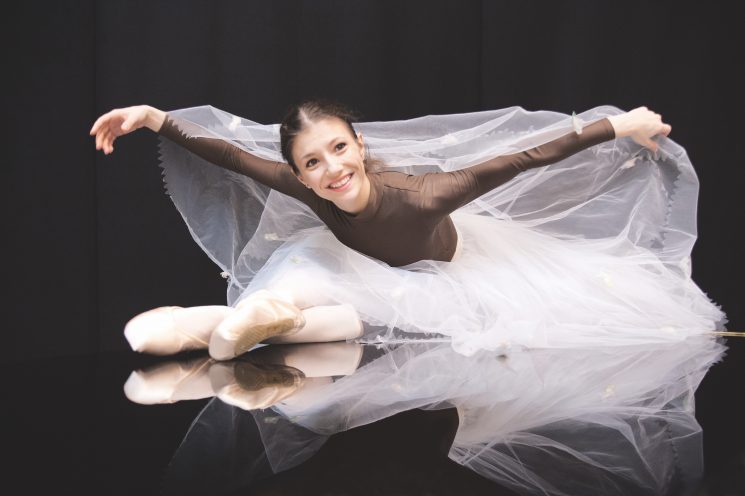
Born in Bucharest, Romania, Alina Cojocaru joined the Royal Ballet School in 1997 and is now principal dancer with the English National Ballet. Photograph © Richard Cannon
Unsung Stories – Eastern Europeans in Britain is on display in Roast until late autumn; eight of the nine photographs are on sale. The restaurant is normally open for breakfast, lunch and dinner from 7am to 10.45pm, with short breaks between meals; on Sunday the restaurant is open for lunch. As a result of the tragic events of Saturday 3 June, the restaurant will be closed until Monday 12 June.
Iqbal Wahhab OBE, distinguished friend and supporter of the MMP, moved into the restaurant business after an early career in the media. He is the founder of two influential restaurants, the Cinnamon Club and Roast, and the author of a number of books, most recently Charity Sucks.



























